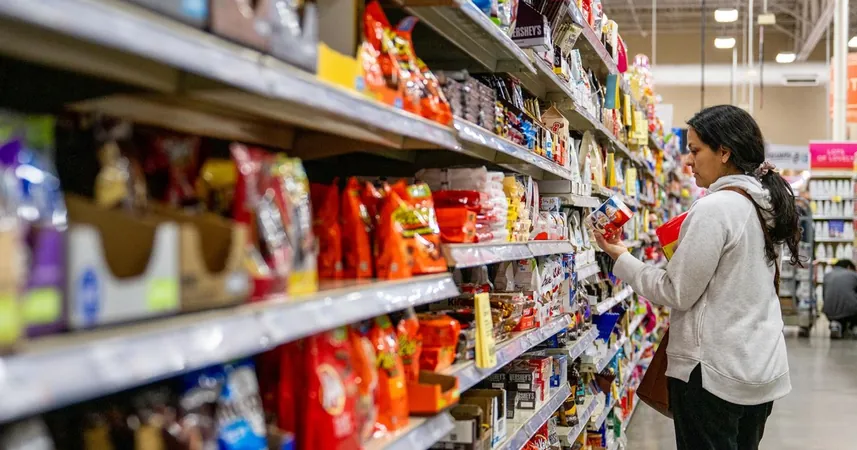
Could Your Favorite Foods Be Slowly Leading You to Type 2 Diabetes? New Study Raises Alarming Concerns!
2025-04-08
Author: Jessica Wong
Could Your Favorite Foods Be Slowly Leading You to Type 2 Diabetes? New Study Raises Alarming Concerns!
Recent research published in the esteemed journal PLOS Medicine uncovers startling evidence linking combinations of common food additives to an increased risk of Type 2 diabetes. This study, which spans eight years and involves over 108,000 adults in the French NutriNet-Santé cohort, suggests that what we consume may be more harmful than we previously thought.
As we dive deeper into the implications of this research, a pattern emerges: many modern diets consist of processed and ultra-processed foods, which are notoriously high in food additives. While much attention has focused on the health risks of individual additives, this groundbreaking study sets itself apart by examining the impact of additive combinations that frequently occur in our diets.
The research identified five distinct mixtures of food additives commonly consumed together. These mixtures resemble ingredient lists found on ultra-processed food labels, sparking concerns about their collective effects.
Here are the shocking mixtures that were identified:
1. Mixture 1
Sodium carbonates, diphosphates, glycerol, ammonium carbonates, potassium carbonates, sorbitol
2. Mixture 2
Modified starches, pectins, guar gum, carrageenan, polyphosphates, potassium sorbate, curcumin, xanthan gum
3. Mixture 3
Magnesium carbonates, riboflavin, alpha-tocopherol, ammonium carbonates
4. Mixture 4
Ammonium carbonates, sodium carbonates, diphosphates, alpha-tocopherol, DATEM, magnesium carbonates, lecithins
5. Mixture 5
Citric acid, sodium citrates, phosphoric acid, sulphite ammonia caramel, artificial sweeteners like aspartame and sucralose, natural dyes, and more.
Of particular concern, the second and fifth mixtures were linked to a heightened risk of Type 2 diabetes among participants. Mixture 2 is dense with emulsifiers and thickeners found in everyday items like plant-based milks and sauces, while Mixture 5 comprises ingredients commonly used in sodas and sugary beverages.
Mathilde Touvier, a prominent nutritional epidemiologist and co-author of the study, expressed the urgency of these findings. She cautioned against dismissing these additives as benign, emphasizing the need for further investigation into their long-term health effects.
Dr. Tom Rifai, an endocrinology expert, shared insights into the nuances of the study. He suggested that these food additives may not directly cause diabetes; instead, they could serve as markers indicating calorie-dense food consumption. This trend highlights a worrying reality: many people may be unaware of the excessive calorie intake associated with ultra-processed food.
In light of growing health concerns, some states are beginning to take action. In 2023, California became a pioneer in banning four harmful food additives, while West Virginia followed suit with a ban on several food dyes. More states, including Illinois and New York, are now evaluating similar legislative measures.
As we draw attention to these alarming revelations, one question arises: Are we aware of what we are truly consuming? The pervasive nature of food additives in our diets suggests that more public awareness and rigorous research are needed. With the average American consuming over half their daily calories from ultra-processed foods, understanding the potential interactive effects of these additives may hold the key to a healthier future.
So, next time you reach for that convenience food, think twice: is it worth the risk?




 Brasil (PT)
Brasil (PT)
 Canada (EN)
Canada (EN)
 Chile (ES)
Chile (ES)
 Česko (CS)
Česko (CS)
 대한민국 (KO)
대한민국 (KO)
 España (ES)
España (ES)
 France (FR)
France (FR)
 Hong Kong (EN)
Hong Kong (EN)
 Italia (IT)
Italia (IT)
 日本 (JA)
日本 (JA)
 Magyarország (HU)
Magyarország (HU)
 Norge (NO)
Norge (NO)
 Polska (PL)
Polska (PL)
 Schweiz (DE)
Schweiz (DE)
 Singapore (EN)
Singapore (EN)
 Sverige (SV)
Sverige (SV)
 Suomi (FI)
Suomi (FI)
 Türkiye (TR)
Türkiye (TR)
 الإمارات العربية المتحدة (AR)
الإمارات العربية المتحدة (AR)